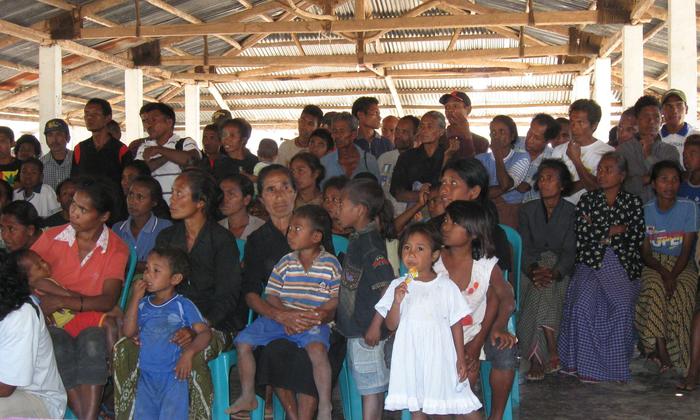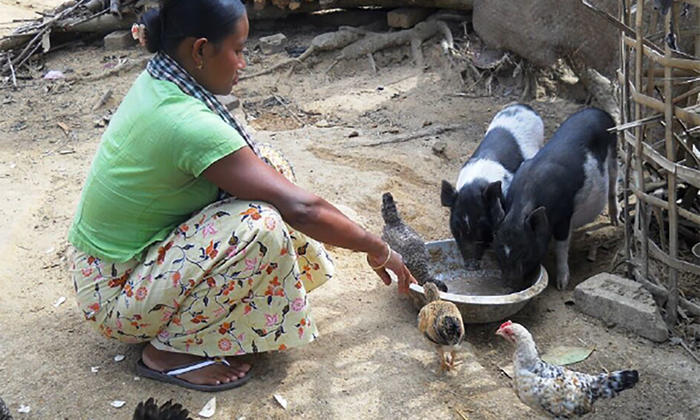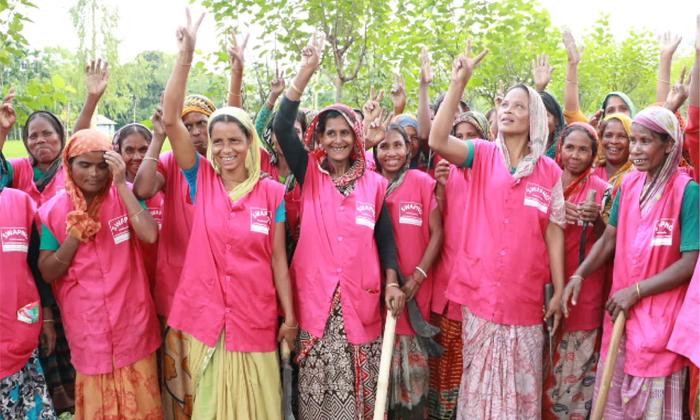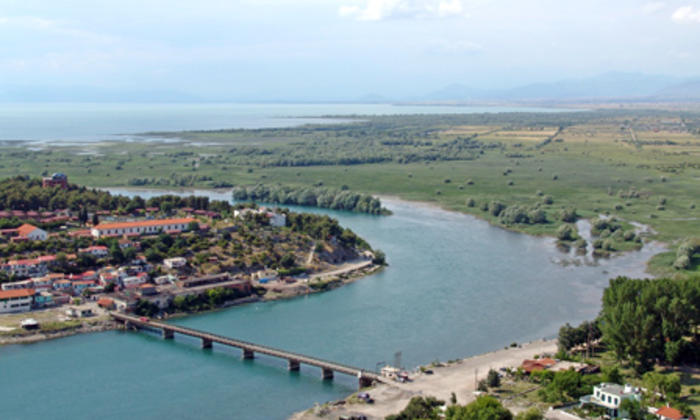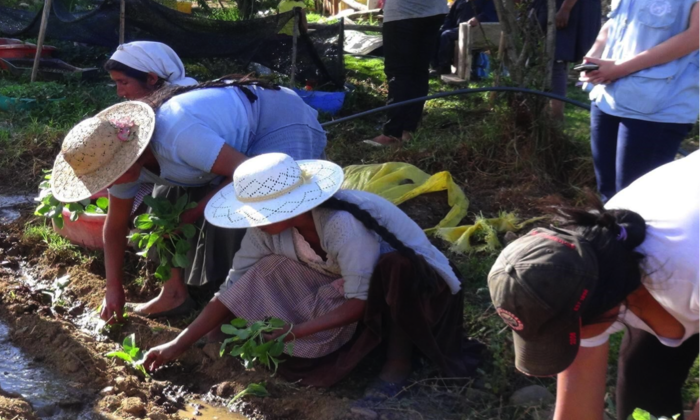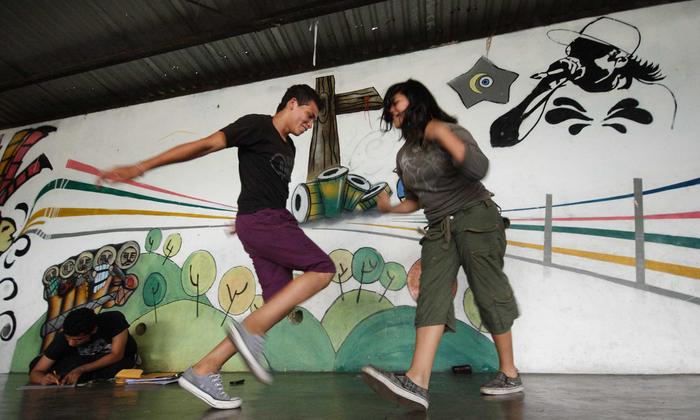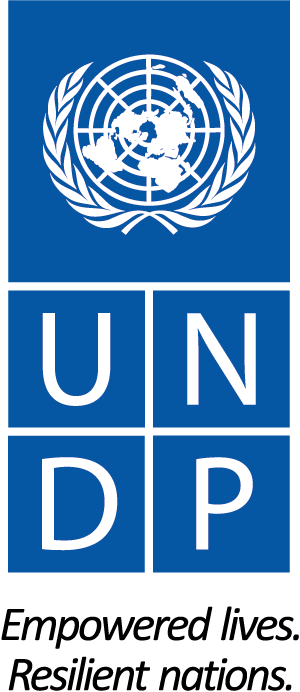Case study
Strengthening the institutional environment for the advancement of women in Guatemala
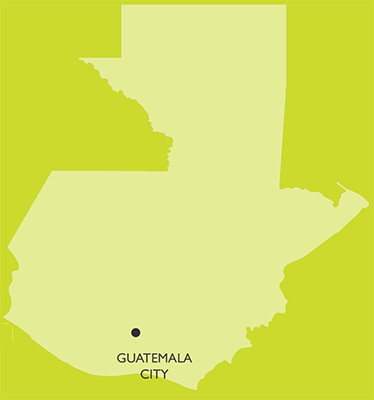
SDGs ADDRESSED
This case study is based on lessons from the joint programme, Strengthening the institutional environment for the advancement of women in Guatemala
Read more
Chapters
Project Partners
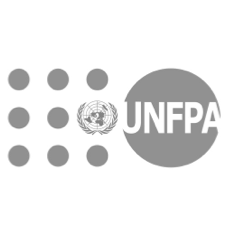
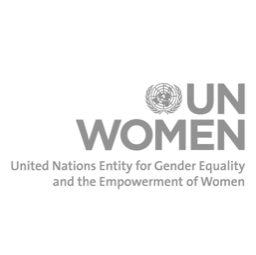
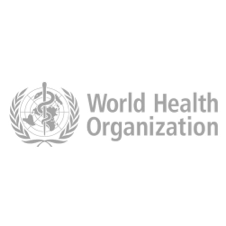
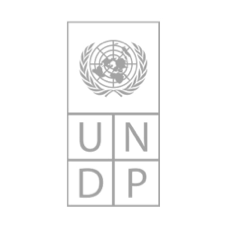
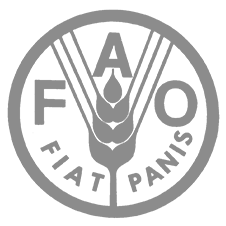
1. SUMMARY
The intervention centred on the strengthening of the Office for the Defence of Indigenous Women (DEMI) and the Presidential Secretariat for Women (SEPREM), with the objective of bringing gender policies and services to the attention of women – particularly indigenous women – in Guatemala.
In order to do this, the programme was based on the National Policy for the Promotion and Integral Development of Women and its Equal Opportunities Plan (PNPDIM-PEO 2008-2023). The activities took place in the departments of Chiquimula, Alta Verapaz, Totonicapán, Huehuetenango, San Marcos, EL Quiché and Sololá, and they revolved around the following foundations:
Strengthening the abilities of technical and administrative personnel by providing training and accountability processes and dialogue between these institutions and women.
Fighting against gender discrimination and violence.
Educating school groups about the elimination of gender stereotypes and themes of violence.
This case study analyses the experiences, lessons learned, results and challenges of the programme developed in Guatemala. The objective is to reinforce and broaden the available knowledge in working for the empowerment of women by strengthening the institutions that safeguard their rights.
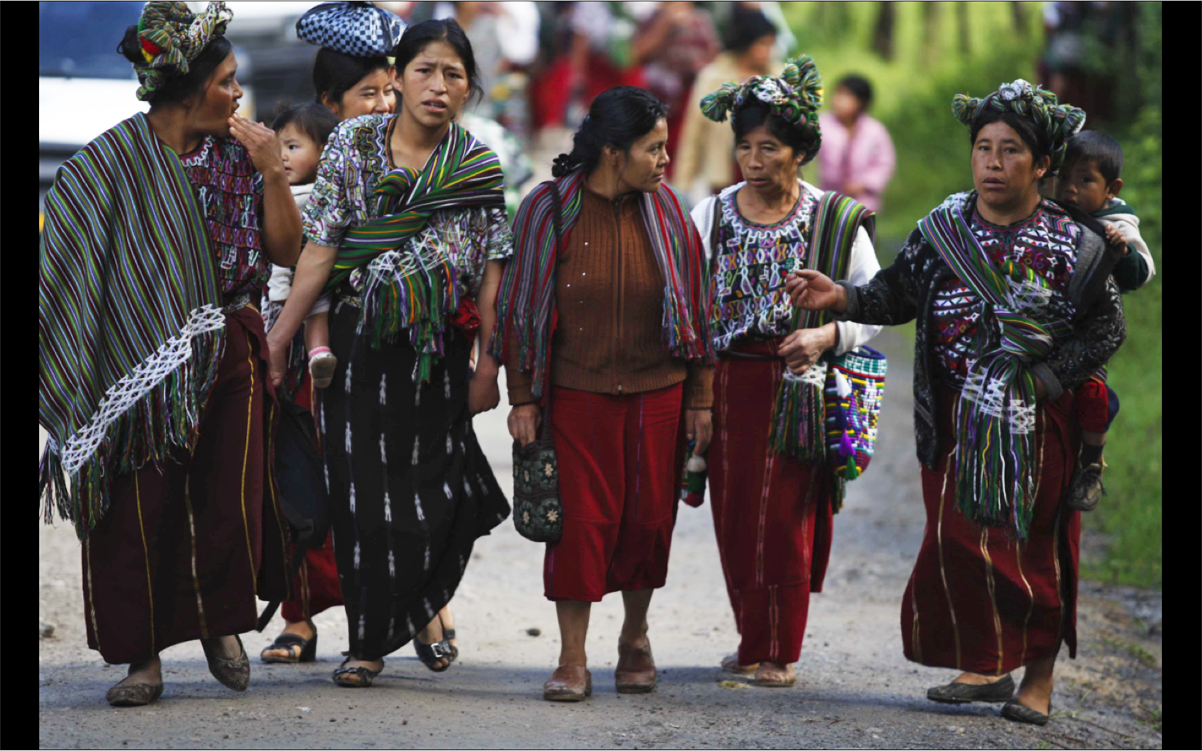
The poverty in Guatemala continues to be largely feminine, rural and indigenous
2. THE SITUATION
Guatemala has various tools for the protection of women’s rights and women’s social, economic, cultural and political advancement. Among them: the Convention on the Elimination of all types of Discrimination against Women; the Inter-American Convention on the Prevention, Punishment and Eradication of Violence against Women; and the American Convention on Human Rights. Of course, there is still a lack of awareness about the national and international legal frameworks in place regarding women’s rights in the country, as well as important budget and institutional shortages in their application.
In this way, the poverty in Guatemala continues to be, above all, feminine, rural and indigenous. In 2006, of the total population considered to be economically active, only 38.3 per cent were women. In the political climate, women – especially indigenous women – come up against greater barriers to access the full scope of their human rights. In the period 2004-2008, only 8.9 per cent of the deputations to Congress and 2.7 per cent of the council positions were occupied by women, of which only 25 per cent were indigenous women.
The root of the developmental problems and issues surrounding the empowerment of women in Guatemala is founded in two interlinked structural questions. The first element, the discrimination that Guatemalans suffer, principally corresponds to historical, social and cultural values that still prevail in the populations’ value system. As such, a large number of social and institutional practices maintain gender inequality. The second aspect has to do with the country accepting the emerging process of democratic institutionalization. The State institutions – especially the gender mechanisms such as SEPREM and DEMO – are showing some institutional disruption, internally as well as in their inter-institutional work with ministries and other Governmental requests.
Additionally, another element to consider is the limited budget that the Government has set aside for SEPREM and DEMI in relation to the extensive mandate that they have undertaken. These institutions have historically had a limited capacity to apply and supervise the existing gender policies, with the added limitation of their scant presence on a departmental scale.

3. STRATEGY
The programme identified the need to strengthen SEPREM and DEMI so that they could better supervise the application of gender policies and their effects, largely at a local level. It also sought to develop proposals and processes of social auditing.
The implementation reached a wide geographical area. It was carried out in seven departments selected for their demographic characteristics and levels of development: Chiquimula, Alta Verapaz, Totonicapán, Huehuetenango, San Marcos, EL Quiché and Sololá. The intervention centred on the following foundations:
- Institutional strengthening of SEPREM and DEMI. Improving their capacity to respond by improving the techniques, management and policies of the technical and administrative staff. Promoting accountability processes and dialogue between these institutions and women, by following advances in the quality of demands put forward by women.
- Institutionalization of the National Policy for the Promotion and Integral Development of Women 2008-23 (PNPDIM), the Equal Opportunities Plan (PEO) and the Articulated Agenda on Indigenous Women in SEPREM and DEMI through the establishment of strategic alliances with the Presidential Secretariat of Planning and Programming (SEGEPLAN), and some line ministries, in particular those of Economy, Public Finance, Public Health, Welfare and Agriculture, and the National Institute of Statistics.
- Preparation of a report on the situation of women and training to eradicate violence and discrimination, improving their economic empowerment and social and political participation.
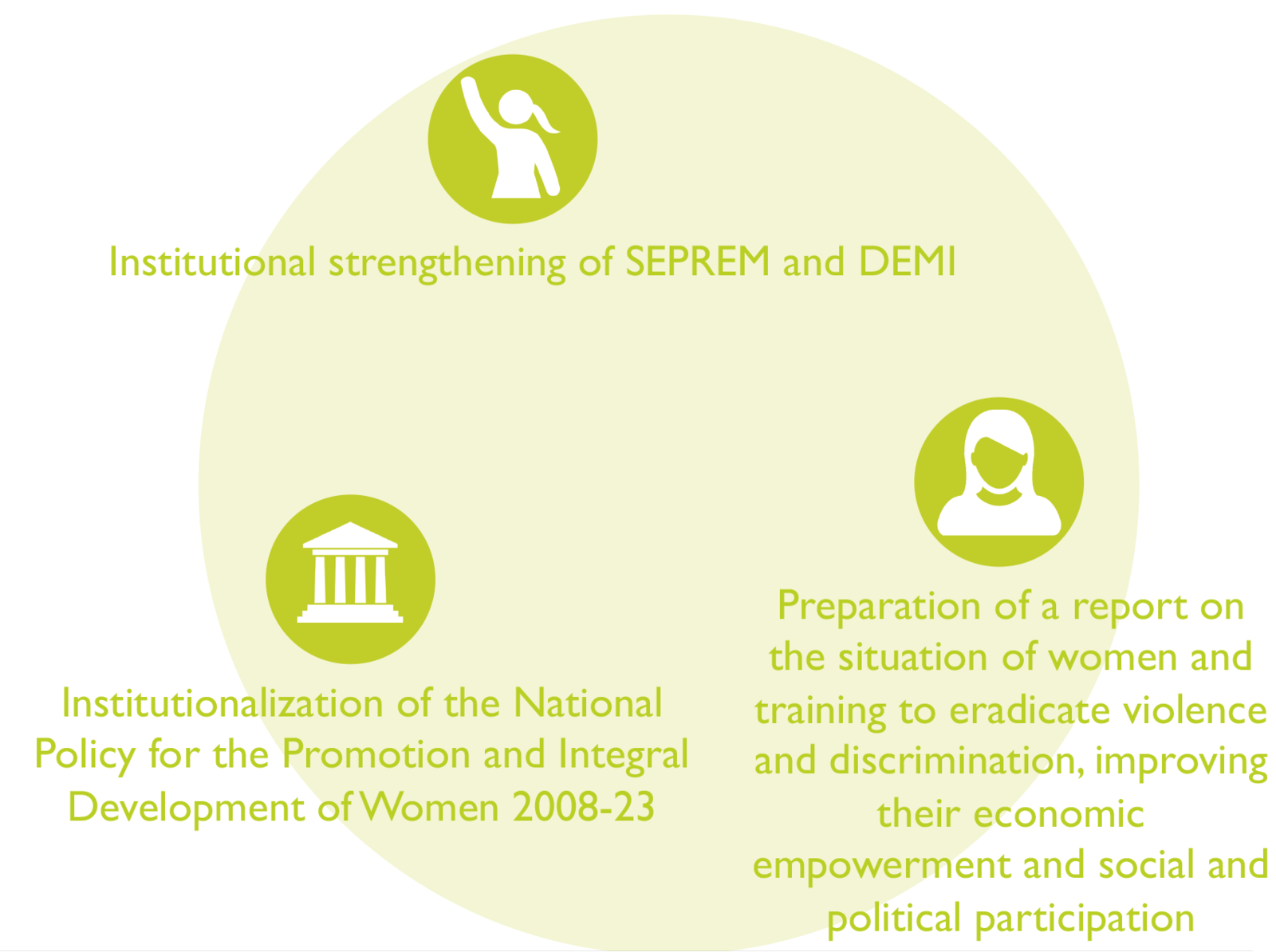
4. RESULTS AND IMPACT
The programme contributed to strengthening bodies such as SEPREN and DEMI, which became public institutions, meaning that their profile within society notably improved. SEPREM’s abilities as a governing body, assessor and coordinator of pro-women public policy were strengthened, and DEMI, in its role as a body for defending the rights of indigenous women at a legislative level, through the promotion and strengthening of the Women’s Commission of the National Congress. Furthermore, the following was achieved:
Institutional Strengthening
- On a national level, the programme improved the technical and management abilities of technical and administrative personnel from 15 state institutions. The work with participating departments allowed female leaders from the local area to be identified and located, by giving them support and awareness about advocacy and political negotiation.
- DEMI opened seven departmental offices which work for 39 municipalities (which constitutes 68 per cent of the indigenous and rural populations), offering prevention, judicial, and psychosocial support (group and individual therapy) to survivors of gender violence. These departmental branches, along with those of SEPREM supported by the programme, influenced the planning process and development of budgets, by focusing them on women’s rights.
- DEMI was enabled to provide services for women who were victims of violence, discrimination and racism on national and local scales. With this support, a total of 9,265 cases were addressed by DEMI across the country.
- Human resources destined for improving the recognition of women within institutions were increased, also on a departmental level. At least 80 per cent of the staff contracted during the execution of the programme were later included in the SEPREM chart, thus guaranteeing the continuity of the processes initiated.
- On a local level, the programme improved women’s participation in decision-making processes, reinforcing and expanding the presence of SEPREM and DEMI in various areas, as well as dialogue with local women’s organizations, strengthening their representation in the system of urban and rural development advice, and offering training in aspects of governance and women’s rights.
The political effect at a legislative level has also been important. Through the strengthening of the Women’s Commission of the National Congress, important legislative advances and regulations for the inclusion of gender perspectives and policies and actions in favour of women were achieved.
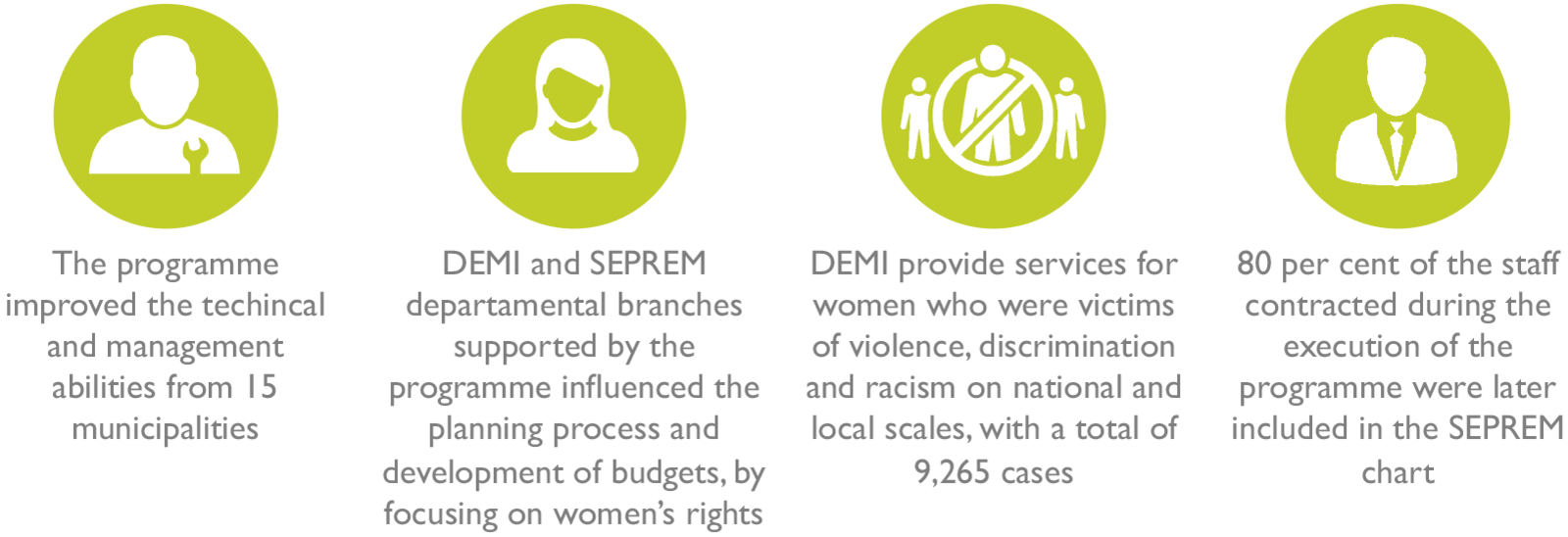
Fight against gender-based violence and discrimination
SEPREN and DEMI prepared a set of tools to strengthen the abilities of their new staff. They standardized good practices and lessons learned, not only related to the programme’s activities, but also those related to the execution of relevant legislation. In addition, the programme used 5 per cent of the departmental development advice budget to put training projects into place specifically for women.
Community awareness in the local environment was crucial for educating people about complaint procedures and the characteristics of violence against women. After the intervention, women, children and teenagers – especially from indigenous and rural backgrounds – had better access to services to prevent and respond to violence. Furthermore, they recognized some of the achievements:
- The creation of the Autonomous Institute for the Political Education of Indigenous Women. They ran intensive courses in political policy education and delivered tools for the development of political campaign strategies and communication to 60 potential candidates for popular election posts.
- The Ministry of Public Education was supported to incorporate gender and ethnicity-related topics into the National Curriculum and into educational and training materials from 2009-2011.
- Seven school groups – 11,514 girls, boys and teenagers – which came from affected areas, received training on the elimination of gender stereotypes and violence.
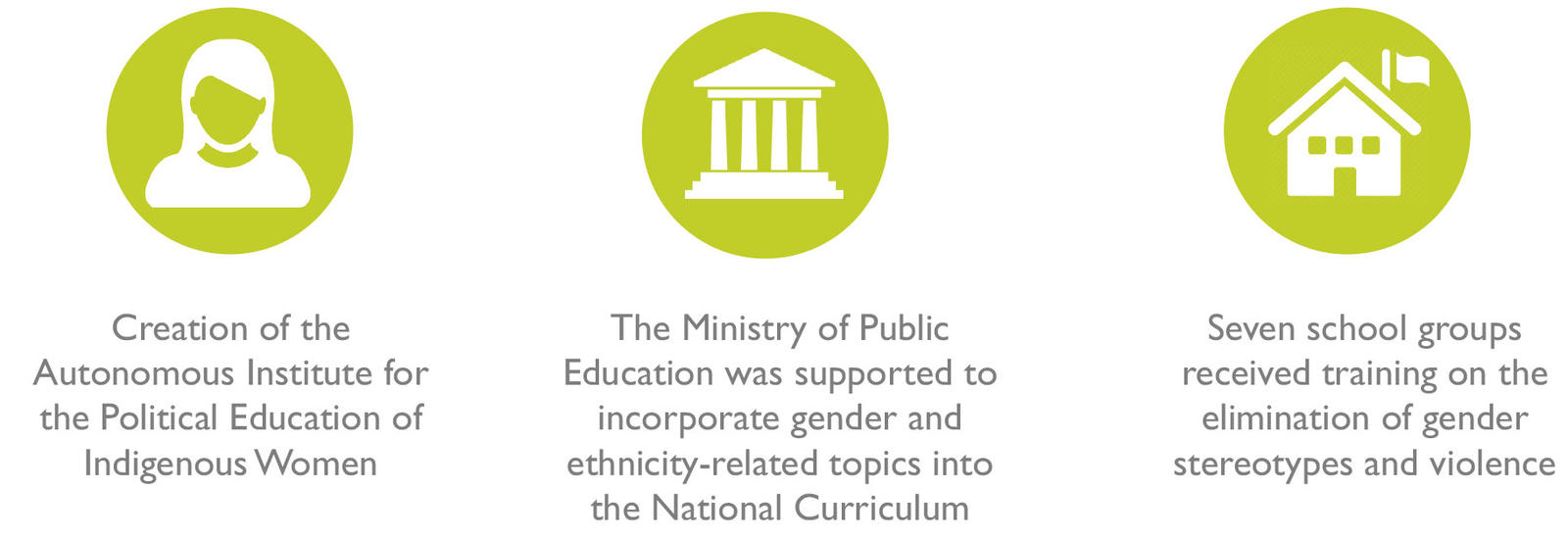
5. CHALLENGES
- Discrimination because of gender continues to be very present in Guatemala and its institutions. One of the problems that persists is the fact that each institution has its own purpose, vision and targets, and these do not necessarily give rise to the recognition of the historical exclusion of women, and indeed many were legitimized and naturalized. This proved to be a barrier to increasing women’s participation in the programme’s activities and decision-making. For future similar interventions, workshops should be organized with the women and men from the communities, in order to confront these attitudes and help to break preconceived social conventions.
- The construction and democratization of a State, post-conflict, has the potential to significantly strengthen the rights and participation of women in decision-making. In these countries, women’s biggest worries about domestic and personal issues (such as family rights, inheritance or access to land) are delegated to institutions which are traditionally discriminatory, or to people who are not from the government. All of these factors imply that women come up against specific barriers to reclaiming their rights and acting as full-fledged citizens.
- The majority of the records concerning cases of violence that have been dealt with are not updated and lack sufficient information regarding ethnic origin, age and municipal district. The term ‘community’ is usually used as though it represents a homogenous, clearly defined structure. Of course, it is therefore essential to get closer to these communities bearing their complexities in mind, and not drawing on incorrect assumptions. Using this information is vital to form a support system appropriate for reality and which responds to the victims’ needs. For future interventions, reinforcing or creating automatic registration systems is recommended.
- The rotation of personnel in medium- or long-duration initiatives – those longer than two years – creates information gaps and long periods of adaptation, which can only be corrected with permanent information strategies and the maintenance of an active institutional memory. Mechanisms need to be designed that ensure continuity to the process, learning and the organization’s institutional memory.
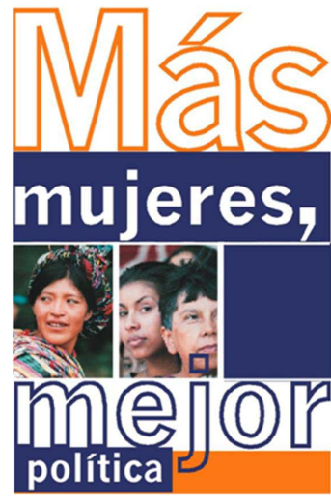
Community awareness was crucial for educating people about complaint procedures on violence against women
6. LESSONS LEARNED
- The programme is a successful reference of the abilities and the impact of the United Nations when its agencies work in a coordinated and multidimensional manner. Each one brought its own knowledge and experience. Of course, in order for the intervention to be successful, it is very important that clear roles are assigned and agreements established about communal objectives, followed by mutual learning by the connected agencies and institutes.
- When dealing with topics as complex as gender-based violence, it is very important to accompany activities with the creation of spaces for training and dialogue, in order to strengthen institutions. These activities not only lead to a better understanding of the magnitude of the problem and how to cover it, but also help to consolidate the institutions, by contributing to the sustainability of the intervention. Strengthening institutions in matters of gender and training society to initiate conversations regarding it are two things that belong together. In this way, if the institutions are coming apart from women’s organizations, then putting the institutions and the civil society into contact with each other may be beneficial to improve the quality of the applications.
- In order to address the subject of violence against women it is vital to rely on the cases’ registration procedures. It is important to organize exercises and local workshops with groups concentrated in the geographical areas with the largest percentages of gender-based violence and this, along with public policy, will work towards its eradication.

7. SUSTAINABILITY AND POTENTIAL FOR REPLICATION
The practices in place for the strengthening of institutions regarding women’s empowerment can provide a reference for the other similar ongoing projects in Guatemala, and also for other countries.
In order to guarantee sustainability of the actions, events must be promoted for sharing the challenges faced and the lessons learned, which will facilitate the retraining of institutional technical staff, but will also ensure that the issue of gender inequality is known by the population. It is necessary to understand the role that society as a whole can and should play to reduce or eliminate gender and ethnic inequality at economic, social, political and environmental levels. In order to facilitate social participation in a country as culturally diverse as Guatemala, it is necessary that space for discussion between civil society and community, municipal and national authorities exists. This is how gender policies can continue to be present in the public agenda.
A complete approach to gender equality in economic, political and social matters was considered indispensable, strengthened by the direct involvement of development advice, such as that for the organization and/or strengthening of the women’s municipal commissions led by SEPREM and DEMI. In the climate of economic empowerment, SEPREM implements national economic policies to promote women’s access to credit and works directly with the Ministry of Finance to strengthen the creation of economic policies.
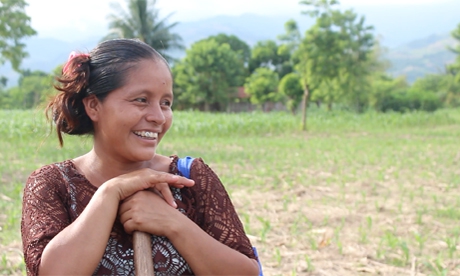
A complete approach to gender equality in economic, political and social matters is indispensable

